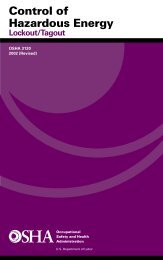Toxic Chemical Release Inventory Reporting Forms and Instructions
Toxic Chemical Release Inventory Reporting Forms and Instructions
Toxic Chemical Release Inventory Reporting Forms and Instructions
You also want an ePaper? Increase the reach of your titles
YUMPU automatically turns print PDFs into web optimized ePapers that Google loves.
<strong>Instructions</strong> for Completing Part II of EPA Form R<br />
1. You determine that the mixture contains an EPCRA<br />
section 313 chemical but the only identity you have for<br />
that chemical is a generic name;<br />
2. You know either the specific concentration of that<br />
EPCRA section 313 chemical component or a maximum<br />
or average concentration level; <strong>and</strong><br />
3. You multiply the concentration level by the total annual<br />
amount of the whole mixture processed or otherwise used<br />
<strong>and</strong> determine that you meet the process or otherwise use<br />
threshold for that single, generically identified mixture<br />
component.<br />
Section 3. Activities <strong>and</strong> Uses of the EPCRA<br />
Section 313 <strong>Chemical</strong> at the Facility<br />
Indicate whether the EPCRA section 313 chemical is<br />
manufactured (including imported), processed, or otherwise<br />
used at the facility <strong>and</strong> the general nature of such activities <strong>and</strong><br />
uses at the facility during the calendar year (see figure 3). You<br />
are not required to report on Form R the quantity manufactured,<br />
processed or otherwise used. Report activities that take place<br />
only at your facility, not activities that take place at other<br />
facilities involving your products. You must check all the<br />
boxes in this section that apply. Refer to the definitions of<br />
“manufacture,” “process,” <strong>and</strong> “otherwise use” in the general<br />
information section of these instructions or Part 40, Section<br />
372.3 of the Code of Federal Regulations for additional<br />
explanations.<br />
3.1 Manufacture the EPCRA Section 313 <strong>Chemical</strong><br />
Persons who manufacture (including import) the EPCRA<br />
section 313 chemical must check at least one of the following:<br />
a. Produce — The EPCRA section 313 chemical is<br />
produced at the facility.<br />
b. Import — The EPCRA section 313 chemical is imported<br />
by the facility into the Customs Territory of the United<br />
States. (See Section B.3.a of these instructions for further<br />
clarification of import.)<br />
And check at least one of the following:<br />
c. For on-site use/processing — The EPCRA section 313<br />
chemical is produced or imported <strong>and</strong> then further<br />
processed or otherwise used at the same facility. If you<br />
check this block, generally you should also check at least<br />
one item in Part II, Section 3.2 or 3.3.<br />
d. For sale/distribution — The EPCRA section 313<br />
chemical is produced or imported specifically for sale or<br />
distribution outside the manufacturing facility.<br />
e. As a byproduct — The EPCRA section 313 chemical is<br />
produced coincidentally during the manufacture,<br />
processing, or otherwise use of another chemical substance<br />
or mixture <strong>and</strong>, following its production, is separated from<br />
that other chemical substance or mixture. EPCRA section<br />
313 chemicals produced as a result of waste management<br />
are also considered byproducts.<br />
f. As an impurity — The EPCRA section 313 chemical is<br />
produced coincidentally as a result of the manufacture,<br />
processing, or otherwise use of another chemical but is not<br />
separated <strong>and</strong> remains in the mixture or other trade name<br />
product with that other chemical.<br />
In summary, if you are a manufacturer of the EPCRA section<br />
313 chemical, you must check (a) <strong>and</strong>/or (b), <strong>and</strong> at least one of<br />
(c), (d), (e), <strong>and</strong> (f) in Section 3.1.<br />
3.2 Process the EPCRA Section 313 <strong>Chemical</strong><br />
Persons who process the EPCRA section 313 chemical must<br />
check at least one of the following:<br />
a. As a reactant — A natural or synthetic EPCRA section<br />
313 chemical is used in chemical reactions for the<br />
manufacture of another chemical substance or of a product.<br />
Includes but is not limited to, feedstocks, raw materials,<br />
intermediates, <strong>and</strong> initiators.<br />
b. As a formulation component — An EPCRA section 313<br />
chemical is added to a product (or product mixture) prior<br />
to further distribution of the product that acts as a<br />
performance enhancer during use of the product.<br />
Examples of EPCRA section 313 chemicals used in this<br />
capacity include, but are not limited to, additives, dyes,<br />
reaction diluents, initiators, solvents, inhibitors,<br />
emulsifiers, surfactants, lubricants, flame retardants, <strong>and</strong><br />
rheological modifiers.<br />
c. As an article component — An EPCRA section 313<br />
chemical becomes an integral component of an article<br />
distributed for industrial, trade, or consumer use. One<br />
example is the pigment components of paint applied to a<br />
chair that is sold.<br />
d. Repackaging — This consists of processing or preparation<br />
of an EPCRA section 313 chemical (or product mixture)<br />
for distribution in commerce in a different form, state, or<br />
quantity. This includes, but is not limited to, the transfer<br />
of material from a bulk container, such as a tank truck to<br />
smaller containers such as cans or bottles.<br />
e. As an impurity — The EPCRA section 313 chemical is<br />
processed but is not separated <strong>and</strong> remains in the mixture<br />
or other trade name product with that/those other<br />
chemical(s).<br />
<strong>Toxic</strong>s <strong>Release</strong> <strong>Inventory</strong> <strong>Reporting</strong> <strong>Forms</strong> <strong>and</strong> <strong>Instructions</strong> 37
















